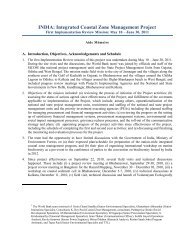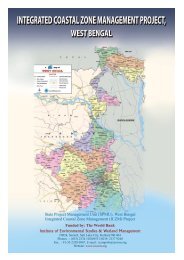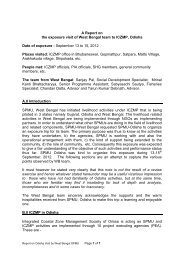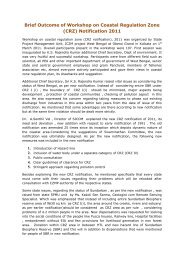Cyclone and Storm Surge - Iczmpwb.org
Cyclone and Storm Surge - Iczmpwb.org
Cyclone and Storm Surge - Iczmpwb.org
You also want an ePaper? Increase the reach of your titles
YUMPU automatically turns print PDFs into web optimized ePapers that Google loves.
6.42<br />
The above recommendations of the total 55 kms of retired embankment shall require l<strong>and</strong> acquisition<br />
of around 1947 hectare costing approximately Rs. 23 Crores as per 1997 price index. Though some<br />
of the acquisition has already been done by now, but considering a gradual rise in l<strong>and</strong> prices, the<br />
cost of acquisition of the remaining l<strong>and</strong> is about Rs. 30 Crore. Construction of these embankments<br />
would require another Rs. 10 Crore.<br />
6.3. Riverbank protection<br />
This is the hard option of protecting a riverbank from failing under erosion. It is seen that the most<br />
critical length of the rivers that need to be protected from failure by bank erosion is the 55 kms<br />
identified in section 8.2 for retirement of the existing embankments. The bank protection has to be<br />
done in a scientific manner, <strong>and</strong> using local material as much as possible. However, it is felt that hard<br />
protections may be avoided since it may so happen that the protected bank remains safe under the<br />
protection but the other banks which are unprotected start loosing a greater amount of material as a<br />
result. Also the cost would be rather high. Instead, the region that is available as a result of retiring of<br />
embankment may be planted with mangrove saplings as mentioned in the following section.<br />
6.4. Mangrove regeneration<br />
Mangroves have been known to help the coastal belts from the ravaging action of waves as<br />
generated by tsunamis or cyclones. As is well known, <strong>and</strong> recorded by Sanyal (2006), when Tsunami<br />
struck the Tamil Nadu during December 2004, the areas behind Pichavaram <strong>and</strong> Muthupet with<br />
dense mangroves suffered fewer human casualties <strong>and</strong> less damage compared to areas without<br />
mangroves. During October 1999, mangrove forests reduced the impact of a super cyclone that<br />
struck Orissa killing at least 10,000 people <strong>and</strong> making 7.5 million homeless. The human settlements<br />
behind mangroves did not suffer loss. During the year 1988 the devastating cyclone of Sundarban<br />
damaged most of the embankments. But after the cyclone it was noticed that the embankments that<br />
had either toe line mangrove plantations or natural mangrove buffer had hardly been damaged. The<br />
most stable portions were the embankments where a ring dyke was also constructed <strong>and</strong> mangrove<br />
regenerated in between them as in the Shikarpur forest campus <strong>and</strong> its vicinity.<br />
Mangroves are efficient silt trappers <strong>and</strong> it has been proved that the delta progradation of Sundarban<br />
largely depend on the sediment trapping by the mangroves. The presence of mangroves at the<br />
intertidal flats on foreshore of the embankments also helps in sediment accretion at the base of the<br />
embankments <strong>and</strong> strengthening it in turn. The dearth of s<strong>and</strong> in the old Digha sea beach is partially<br />
related to the mangrove clearance of Digha Mohana estuary for a large scale co-operative Fishery
















